Advertisements
Advertisements
Question
The highest refractive index is of ______.
Options
Glass
Water
Diamond
Ruby
Solution
The highest refractive index is of Diamond.
APPEARS IN
RELATED QUESTIONS
A student very cautiously traces the path of a ray through a glass slab for different values of the angle of incidence (∠i). He then measures the corresponding values of the angle of refraction (∠r) and the angle of emergence (∠e) for every value of the angle of incidence. On analysing these measurements of angles, his conclusion would be
(A) ∠i > ∠r > ∠e
(B) ∠i = ∠e > ∠r
(C) ∠i < ∠r < ∠e
(D) ∠i = ∠e < ∠r
State the dependence of angle of deviation On the wavelength of light
In the adjacent diagram, AO is a ray of light incident on a rectangular glass slab.
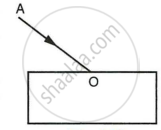
- Complete the path of the ray till it emerges out of the slab.
- In the diagram, mark the angle of incidence (i) and the angle of refraction (r) at the first interface. How is the refractive index of glass related to the angles i and r?
- Mark angles of emergence by the letter e. How are the angles i and e related?
- Which two rays are parallel to each other? Name them.
- Indicate in the diagram the lateral displacement between the emergent ray and the incident ray. State one factor that affects the lateral displacement.
How does the angle of minimum deviation produces by a prism change with increase in :
the wavelength of incident light
Fill in the blanks to complete the following sentence
When light travels from a denser to a rarer medium, its speed ……………….
Fig shows a lens as a combination of a glass block and two prisms.
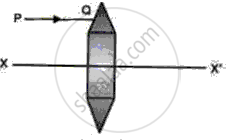
(i) Name the lens formed by the combination.
(ii) what is the XX' called?
(iii) Complete the ray diagram and show the path of the incident ray PQ after passing through the lens.
(iv) The final emergent ray will either meet XX' at a point or appear to come from a point on XX'. what is the point called?
Explain briefly what causes the twinkling of stars at night.
In the diagram below, PQ is a ray of light incident on a rectangular glass block.
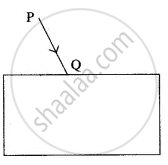
How are the angles ‘i’ and ‘e’ related to each other?
The path of a ray of light coming from air passing through a rectangular glass slab traced by four students are shown as A, B, C and D in the figure. Which one of them is correct?
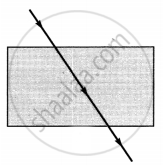 |
 |
 |
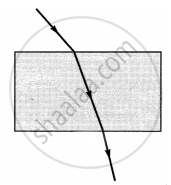 |
| A | B | C | D |
Which colour of white light travels fastest in any medium except air?
